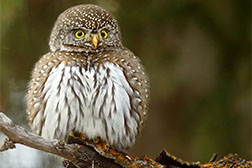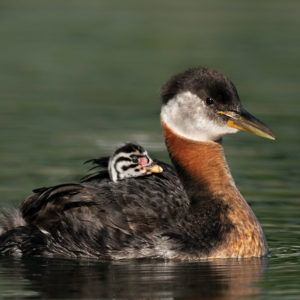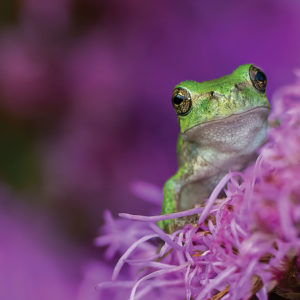The Northern Pygmy Owl

Valerie Assinewe,
Guest Blogger
This blog was written by guest blogger Valerie Assinewe.
Tiny, fast and feisty, the Northern Pygmy Owl is this month’s feature in our 2016 Nature Canada calendar.
Where do they live?
The range of the Northern Pygmy Owl (Glaucidium gnoma) extends from the western forests of Alaska to Central America. Its preferred habitat in British Columbia and Alberta, as elsewhere in its range, is open coniferous and mixedwood forests. As they are a non-migratory bird, they may wander out of their breeding areas in fall and winter to lower elevations for easier hunting.
What do they look like?
The Northern Pygmy Owl is small and compact: ~16 cm long …about the length of a smart phone. This owl has a large, circular head that lacks ear tufts, with two black “eye-spots” located on the back of the head. The body has dark brown plumage with heavily streaked undersides: the upper parts are dark grey-brown speckled with white, and the under-parts are predominantly white with large grey-brown patches on the sides of the breast and dark streaks. The tail is long and barred, and the wings are short and rounded.
What do they eat?
Unlike other owls, the Northern Pygmy Owl is diurnal: it hunts during the day. However, it prefers to hunt at dawn and dusk.
The Northern Pygmy Owl diet consists largely of small rodents and songbirds. Reptiles, amphibians and insects are also prey. Despite its small size, the Northern Pygmy Owl is an aggressive hunter, and has been known to capture birds bigger than twice its size – even chickens!
How do they reproduce?
Northern Pygmy Owls form monogamous pairs in the spring. The female incubates 2-7 eggs, but often only 3-4, for about 28 days. While she is incubating, the male hunts and brings food to the female. She broods the hatchlings during their first week while the male continues to supply food to the nest. After that, both parents take part in providing food, the male bringing much of prey and the female feeding it to young. The owlets begin to fly at 27-28 days.
Breeding begins at one year of age, and birds breed every year.
Fun Facts:
- Northern Pygmy Owls raise a pair of tufts on the sides of their head when threatened by a predator, such as a hawk or a cat.
- The oldest recorded Northern Pygmy Owl was a male. He was at least 3 years, 11 months old when recaptured and re released during banding operations in Oregon.
- They have a “perch and pounce” hunt tactic; so if you want to see a Northern Pygmy Owl, look for them perched at the very top of a snag or tree.
- You can also sometimes find them in at the centre of a loud commotion; hummingbirds, wrens, warblers, jays, and blackbirds often mob Northern Pygmy Owls.
Like other cavity nesters, Northern Pygmy Owls need standing dead trees as nest sites. This nesting preference, prey availability and reduced habitat are threats to this feisty owl. Your continued support to Nature Canada helps sustain our efforts to manage and protect the coastal, montane and subalpine forests that provide a home to the Northern Pygmy Owls and the many species critical to its survival.



